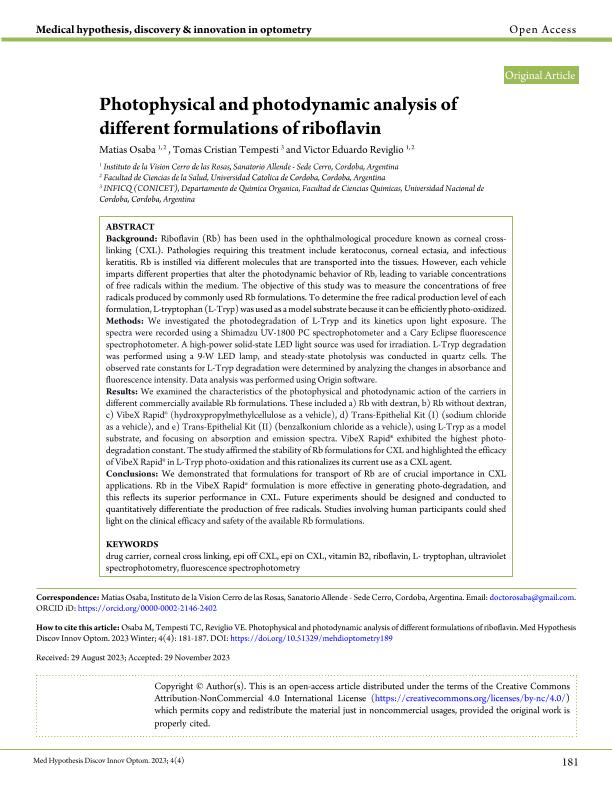Mostrar el registro sencillo del ítem
dc.contributor.author
Osaba, Matías

dc.contributor.author
Tempesti, Tomas Cristian

dc.contributor.author
Reviglio, Victor Eduardo

dc.date.available
2024-02-14T13:13:29Z
dc.date.issued
2023-12
dc.identifier.citation
Osaba, Matías; Tempesti, Tomas Cristian; Reviglio, Victor Eduardo; Photophysical and photodynamic analysis of different formulations of riboflavin; International Virtual Ophthalmic Research Center; Medical hypothesis, discovery & innovation in optometry; 4; 4; 12-2023; 181-187
dc.identifier.uri
http://hdl.handle.net/11336/226832
dc.description.abstract
Background: Riboflavin (Rb) has been used in the ophthalmological procedure known as corneal cross-linking (CXL). Pathologies requiring this treatment include keratoconus, corneal ectasia, and infectious keratitis. Rb is instilled via different molecules that are transported into the tissues. However, each vehicle imparts different properties that alter the photodynamic behavior of Rb, leading to variable concentrations of free radicals within the medium. The objective of this study was to measure the concentrations of free radicals produced by commonly used Rb formulations. To determine the free radical production level of each formulation, L-tryptophan (L-Tryp)was used as a model substrate because it can be efficiently photo-oxidized. Methods: We investigated the photodegradation of L-Tryp and its kinetics upon light exposure. The spectra were recorded using a Shimadzu UV-1800 PC spectrophotometer and a Cary Eclipse fluorescence spectrophotometer. A high-power solid-state LED light source was used for irradiation. L-Tryp degradation was performed using a 9-W LED lamp, and steady-state photolysis was conducted in quartz cells. The observed rate constants for L-Tryp degradation were determined by analyzing the changes in absorbance and fluorescence intensity. Data analysis was performed using Origin software.Results: We examined the characteristics of the photophysical and photodynamic action of the carriers in different commercially available Rb formulations. These included a) Rb with dextran, b) Rb without dextran, c) VibeX Rapid® (hydroxypropylmethylcellulose as a vehicle), d) Trans-Epithelial Kit (I) (sodium chloride as a vehicle), and e) Trans-Epithelial Kit (II) (benzalkonium chloride as a vehicle), using L-Tryp as a model substrate, and focusing on absorption and emission spectra. VibeX Rapid® exhibited the highest photo-degradation constant. The study affirmed the stability of Rb formulations for CXL and highlighted the efficacy of VibeX Rapid® in L-Tryp photo-oxidation and this rationalizes its current use as a CXL agent.Conclusions:We demonstrated that formulations for transport of Rb are of crucial importance in CXL applications. Rb in the VibeX Rapid® formulation is more effective in generating photo-degradation, and this reflects its superior performance in CXL. Future experiments should be designed and conducted to quantitatively differentiate the production of free radicals. Studies involving human participants could shed light on the clinical efficacy and safety of the available Rb formulations.
dc.format
application/pdf
dc.language.iso
eng
dc.publisher
International Virtual Ophthalmic Research Center
dc.rights
info:eu-repo/semantics/openAccess
dc.rights.uri
https://creativecommons.org/licenses/by-nc/2.5/ar/
dc.subject
DRUG CARRIER
dc.subject
CORNEAL CROSS LINKING
dc.subject
EPI OFF CXL
dc.subject
RIBOFLAVIN
dc.subject.classification
Otras Ciencias Químicas

dc.subject.classification
Ciencias Químicas

dc.subject.classification
CIENCIAS NATURALES Y EXACTAS

dc.title
Photophysical and photodynamic analysis of different formulations of riboflavin
dc.type
info:eu-repo/semantics/article
dc.type
info:ar-repo/semantics/artículo
dc.type
info:eu-repo/semantics/publishedVersion
dc.date.updated
2024-02-09T12:15:48Z
dc.identifier.eissn
2693-8391
dc.journal.volume
4
dc.journal.number
4
dc.journal.pagination
181-187
dc.journal.pais
Estados Unidos

dc.journal.ciudad
Texas
dc.description.fil
Fil: Osaba, Matías. Universidad Católica de Córdoba. Facultad de Medicina; Argentina
dc.description.fil
Fil: Tempesti, Tomas Cristian. Consejo Nacional de Investigaciones Científicas y Técnicas. Centro Científico Tecnológico Conicet - Córdoba. Instituto de Investigaciones en Físico-química de Córdoba. Universidad Nacional de Córdoba. Facultad de Ciencias Químicas. Instituto de Investigaciones en Físico-química de Córdoba; Argentina
dc.description.fil
Fil: Reviglio, Victor Eduardo. Universidad Católica de Córdoba. Facultad de Medicina; Argentina
dc.journal.title
Medical hypothesis, discovery & innovation in optometry
dc.relation.alternativeid
info:eu-repo/semantics/altIdentifier/url/https://mehdijournal.com/index.php/mehdioptometry/article/view/1121
dc.relation.alternativeid
info:eu-repo/semantics/altIdentifier/doi/http://dx.doi.org/10.51329/mehdioptometry189
Archivos asociados
